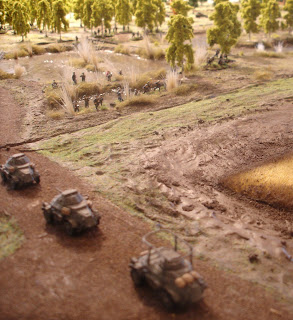I painted the horses at the same time I was painting my WW2
Australians – there should be a distinct similarity in colour between them and
the Australian rifle stocks. It was just a background
task and progress was slow, but then I put them onto my “one colour a day”
program and voila!
The hardest decision as always was just how much detail to
attempt. As an elite unit I did a little
bit more than normal.
The only problem I had was the officer. He was cast with his arm straight
out to the side, parallel to the ground and perpendicular to the horse. I based him by himself (as in just three
figures on the command base). But it
just didn’t look right and so the next morning, bright and early, I took a firm
grip of his arm and bent it down. It was
if he understood and relaxed his arm to point down. Then I cut figures off the base to rearrange
them to the standard four figure configuration.
































